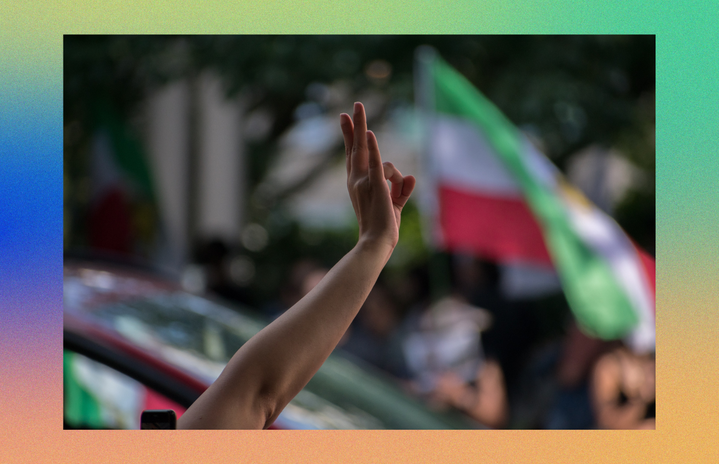For the average American, like many humanitarian crises, the ongoing protests and response from the Iranian government are nothing more than the intermittent graphic on an Instagram story. Sometimes these graphics get circulated and snowball into a mass posting on Instagram (a phenomenon we Gen-Zers know all too well), but usually, the awareness fizzles out in, well, the 24-hour posting period.
However, the more you learn about the current situation in Iran, the more you begin to question: Really, why is no one talking about this? The answer, as with all human rights issues, is a complicated one and one that should be reached individually.
That being said, there’s something to be said for educating yourself on events occurring beyond your borders, beyond your social media screens, and beyond your understanding of (westernized) feminism.
Why is Iran in The News?
The history of the hijab is a long and colorful one—while I am focusing on modern history, I cannot recommend enough the book “Do Muslim Women Need Saving?” by Lila Abu-Lughod for more information on the practice of veiling.
On Sept.13, 2022, Mahsa Amini was arrested, beaten, and eventually killed by Iranian officers who initially detained her for a (disputed) violation of a rule requiring women to cover their hair with a hijab.
For a considerable period in the 20th century, women were not required to wear head coverings, although many did as a personal choice (for more on feminism and the headscarf, see below). The 1979 Islamic Revolution changed this with the hijab law—and since 1983, wearing hijab has been strictly and legally enforced for all women in Iran—including non-Muslims and foreigners.
Since then, mandatory hijab laws have become more and more restrictive. Criminal punishment for violation of hijab laws was first introduced in the 1990s and has continued since.
In 2018, punishment for violation of mandatory hijab laws shifted from imprisonment and fines to forced attendance at Islam educational classes. The “morality police,” also known as Guidance Patrol or Gasht-e Ershad, typically detain women in violation of the hijab law and transport them to a class, where they are “required to sign a form saying they will not commit the “bad hijabi” offense again, and forced to take part in police-organized “guidance” to learn how they should observe Islamic value.”
Because of the vagueness of the law itself, it often falls upon the enforcers to interpret the law. We Westerners know as well as anyone that a loose interpretation of the law by police forces can end in violence, murder, and injustice.
Although this law has been in place for decades, Amini’s death has sparked outrage among Iranian women and human rights activists everywhere.
In Saqqez, women began to rip their head coverings off at Amini’s funeral. Protests have “swelled” since then—from women setting their hijabs on fire or cutting their hair in public, a mass protest surrounding the mandatory hijab law is currently taking place in Iran.
Authorities have reacted forcefully. According to Iran Human Rights, there have been 470 executions in 2022 so far.
There has also been disruption to internet and phone services, making it difficult for activists to gain international traction. While the EU and UK have sanctioned Iranian officials, sanctions have not always worked as a meaningful way to stop a country’s actions (find a more descriptive argument for why sanctions aren’t always effective in this article).
What’s Happening Currently?
Please note that this article was last edited on November 14, 2022, and newer updates will likely be available by the time of its publishing.
The most recent updates on Iran show a situation that is anything but under control or peaceful. As of November 14, 2022, the Iranian courts have begun sentencing anti-government protesters to death. More than 1,000 indictments have been issued just in Tehran, the capital of Iran.
Furthermore, Germany and Iceland have submitted a request to hold a special UN Human Rights Council session soon, which will take place later this month.
For longevity’s sake, delving into current, daily events is not the main focus of this article—for updates, check out websites like AlJazeera, The New York Times, and the BBC.
Why Are The Iran Protests So Swept Under The Rug By Western Media?
If protests and human rights violations of this caliber were occurring in western countries (meaning Europe and the United States, mainly), public outrage would leak into every aspect of everyday life. Instead, we’re reminded of the ongoing crises and deaths in Iran by the occasional Instagram post or Twitter hashtag. Why?
To argue that the lack of awareness on this issue is simply due to physical distance from Iran is to squeeze centuries of colonialism, whiteness, and sexism into a tiny box. After all, Australia is further away from the United States than Iran, but its whiteness and adherence to western culture ensure that we would be aware of any wrongdoings in the country faster than you can say “kangaroo.”
First of all, highly publicized outrage against forcing women to present themselves in a certain way would almost immediately get turned back around onto our known and trusted governments. France, revered as a leader in quality of life and democracy, as well as western thought, has recently banned “conspicuous religious symbols” in sports competitions and schools; symbols that almost always are directly applied to French Muslim women. While the west is no stranger to hypocrisy (in fact, many of the United States enemies use our history of slavery, colonialism, sexism, and racism to debunk our humanitarian claims against them), France’s limitations on women’s dress may seem a little bit too familiar to the average western activist. How can you call out a country severely oppressing Muslim women while you are (perhaps not as violently, but nonetheless) as well?
France aside, there’s an incredibly large gap of knowledge surrounding the practice of wearing hijab that westerners, feminists, and misogynists alike, refuse to fill.
A quick history lesson*: when American feminism began to fall apart in the 1970s, due to party fragmentation and other issues, feminists began to grasp onto feminist issues that were easy to mobilize around and hard to argue against—one of these issues being the hijab.
*From this point on, unless otherwise noted, information is from“Do Muslim Women Need Saving?” by Lila Abu-Lughod.
By this time in history, western feminism was widely associated with bare skin and flaunted sexuality. The hijab not adhering to these values caused it to be ignored and demeaned as a means of self-expression. There was also intense party disagreement on women’s issues in the United States, from rape law to domestic abuse rates to abortion. Focusing on women abroad was a way to further feminist thought, without dealing with the nitty-gritty and exhausting fights on the home front.
However, while western (and often white) feminists built a common defense against the “patriarchy” abroad, the patriarchy was almost always associated with the middle-eastern man, especially after the Sept. 11, 2001 attacks.
Let’s look at the sudden concern about Muslim women after 9/11. The US justified military intervention in Afghanistan to “defend the rights of muslim women” in 2001. There is an incredibly strong colonial history of the white, “civilized” man saving women of color abroad from men of color abroad. It’s no coincidence that the United States government became incredibly invested in Musilm women’s livelihoods after 9/11—right when they could use them as an excuse to spread imperialism and western ideas—and get our hands on those middle-eastern oil reserves.
Scholar Abu-Lughod brings up several key points regarding this policy, from white western feminists and the United States government alike: Muslim women are not just from the middle east, their choice to wear hijab is often, well… their choice (read this Washington Post article by Nadia B. Ahmad and Asifa Quraishi-Landes to begin debunking biases that wearing hijab is a form of oppression), and the United States government is focusing on religion and culture abroad instead of the regimes, politics, and history that has brought countries like Iran to where they are today. If this section hasn’t made it clear, read Abu-Lughod’s book.
Long story short, western culture doesn’t know and frankly doesn’t care enough about the hijab or lack thereof to truly interject on the Iranian protests so, we aren’t. Should we be?
I am not enough of an expert (in fact, I am not an expert at all) to answer this question. Obviously, taking action against injustice in a perfect world would be easy and straightforward. Unfortunately, that is not the world we live in, and the United States rarely intervenes in other countries’ struggles without at least a little self-interest.
As pointed out by Abu-Lughod, the rhetoric of “saving” women abroad is loaded with implications of western superiority and the idea that you can’t be a feminist unless you’re the skin-baring, anti-shaving, outspoken model of western feminism that we all know. But feminism exists where women exist and forcing our ideals of feminism (which are not perfect by any means—read more on the issues with American white feminism here) is certainly not the way to pave a path towards worldwide gender equality.
Ultimately, this article is meant to be a starting point for growing your perception of feminism and injustice beyond the western paradigm, and a white female author like myself telling readers what they should do seems completely contradictory to that goal. There are plenty of incredibly strong, intelligent, and, most importantly, non-western women who are speaking out while western media stays wholly silent—all you have to do is put the energy into finding them.
Start here:
Leila Ahmed- Women and Gender in Islam
Margot Badran: Feminists, Islam, and Nation: Gender and the Making of Modern Egypt
Marjane Satrapi: Persepolis (Novel)
Marjane Satrapi: Persepolis (Film)
I, the author, have read all the literature recommended above. That being said, the field of non-western feminism is vast and ought to be explored beyond my personal recommendations.


